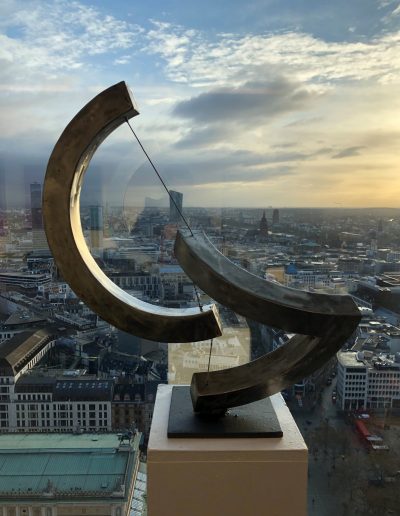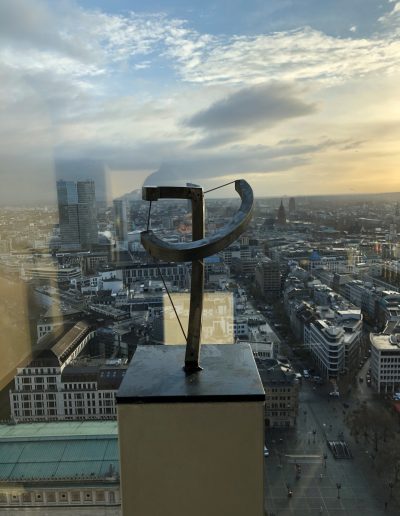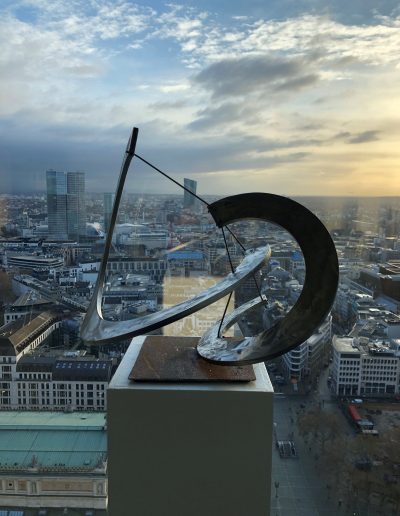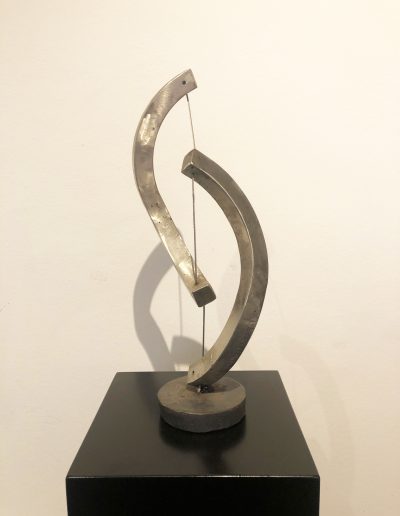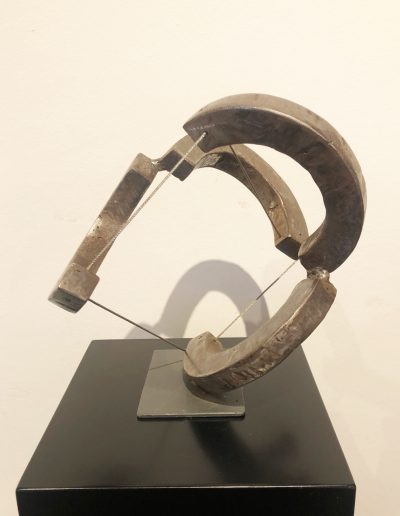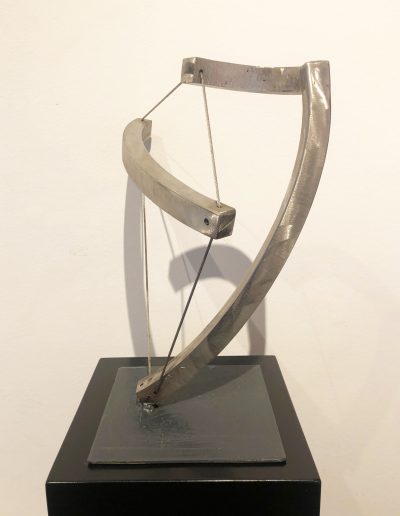Matthias Will
WORKS // INFO // BIOGRAPHY // EXHIBITIONS // WORKS IN PUBLIC
WORKS
ARTIST
Matthias Will
Exciting …
Notes on the work of Matthias Will
To claim that a work of art is “exciting” is a popular way of avoiding an evaluation in a conversation about art. To avoid taking an unambiguous position and thus to be able to mark a subjective position without claiming general validity, which at least states that the work in question does not bore the viewer, which is already worth quite a bit, and that it is thus worthwhile to deal with it.
More concretely, one could talk about various tensions that play a role in dealing with works of art, something like the tension between the respective biography of the work, the span between early and more recent works, the tension between art and context, between work and viewer, the tension between different works in a common exhibition, between works by different artists, and more. And of course there are also tensions within a work – between content and form, or even, in the sense of a contrapost, within the formal structure as such.
As far as Matthias Will’s works are concerned, however, the term “tense” is to be taken literally, beyond what has been stated. For without tensioned ropes, Will’s works would not be feasible at all. The steel works of the artist, who was born in 1947 in Kahl am Main, Germany, and who first studied art education in Frankfurt and then sculpture at the Städelschule there, consist of several parts and take shape solely through the force of the tension. If this is loosened, the work of art disintegrates into its components.
Will’s works thus use the means of physics, which is responsible for our world located between microcosm and macrocosm, to imagine elementary tension relationships of mass and energy that are also effective beyond this. They thematize the formative power of the energetic. In doing so, and this is what makes his works so astonishing, Will goes to the limits of what is physically possible. He performs virtuoso and acrobatic “tightrope acts” and thus opens up possibilities for the genre of sculpture that were previously only familiar in the field of art in the medium of painting. A small digression may clarify this: Space can only be represented indirectly in the two-dimensionality of painting. As is well known, the Renaissance developed a perfect, scientifically based system of spatial imagination with the central perspective, which is, however, statically oriented in that it aligns all details solely to a single point of view. On the other hand, it is easily possible to visualize physically impossible events in a believable way, such as the floating up of some saints into the sky or their sitting on a comfortable heavenly cloud.
Three-dimensional sculpture, on the other hand, is bound by the prevailing laws of physics, the laws of space, the relation of space and time, the conditions of gravity and statics. Here lie its specific advantages, but also the aporias and specific challenges with which the artist is confronted if he wants to depict movement, possibly levitation and flight. Conventional sculpture is static and earthbound. It stands on a pedestal or lies on the ground – even a representation of a standing human being, one of the most common themes of traditional sculpture, is technically impossible without a pedestal or other supporting elements, from which it becomes clear that our standing on two legs is not a static but a highly dynamic event, since in “real life” it requires a constant active – albeit unconscious – balancing of the respective position. Dead or sleeping people cannot stand.
Heaven and earth, and horizontally we orient ourselves forward and backward as well as right and left, which ultimately results in a square, the ancient symbolic form of the measurable, or a circle as we move about our axis, the sign of the incommensurable, infinity and perfection.
This, then, is our limited and yet so immeasurable world, with which we nevertheless do not resign ourselves, for it is precisely from such bondage that our longing to overcome it results. The age-old dream of being able to fly, of which the widespread fear of flying is only the flip side, has taken us far, at least as far as the moon, but we will hardly get much further, despite all our efforts. Significantly, the architecture of our mobile age often negates the earthiness that is also indispensable for it: with concrete stilts and high-rise projects – currently booming like never before, Babylon sends its regards – it pretends to be able to ignore physical limitations.
There were already comparable tendencies in the Gothic period, albeit under different auspices, and sometimes with disastrous consequences. And already from prehistoric and archaic times we know sculptures that lack the grounding. They were probably held in the hand or carried on the body – in any case they could not be placed, at best they could be laid down. Nomads, hunters and collectors could hardly have found a sensible location for the erection of monuments. The famous bronze angel by Ernst Barlach, to cite a more recent example, hangs on iron chains. Only in more recent times has it become the rule for the sculpture to leave its pedestal, but it is still unable to rise into the air, unless it is suspended like Calder’s mobiles.
Will – and I quote from a text by Roland Held – uses “the basic elements circle and square, cube and cuboid, sphere and cylinder, which he has varied and combined over many years, sawing, cutting, welding, screwing, lashing.” In this respect, his art would not be further innovative, not even if the constructive concept “the craftsmanship sometimes opposes the rough edge,” “more often still the rusty or flex-drawn surface. The conceptual of the work as a whole thus experiences a certain relativization through the commitment to handwriting and materiality, beginning with the choice of iron as a material, which Will simply loves for its heaviness.”
He loves it to teach him to fly. This is another thing he has in common with the masters of the Gothic: to test what the material is capable of, to challenge it to the limits of its possibilities. Will loves paradox, loves squaring the circle. Thus it is also in decided contradiction to the idea of constructivism, which is unquestionably binding for him, that he, contrary to what one might assume, proceeds improvising rather than constructing, that he does not prepare and work out his designs on paper, but tries them out in small models until he has reached that intuitively grasped point of coherence which – according to his own words – distinguishes art from design and mere decoration.
Will uses mostly “normal” rusting steel for smaller works, but weather-resistant stainless steel for larger ones. However, he always makes a point of “painterly” modifying the material and form’s inherent technical perfection by structuring the surface. But it is not only the contrast between form and surface that creates a tension in his works, but also, and even more so, the way in which the parts relate to the whole in the works, which basically consist of several elements – often only two elements juxtaposed in dialogue.
As a rule, the segments, which are related to each other in different ways, originate from a disassembled basic geometric form. From their separation and reassignment, however, the new, the different, the surprising emerges: A spatial, dynamized structure, a metamorphosis that may be succinct and coherent, even rationally comprehensible, but in the fewest cases is immediately transparent – although the artist does not conceal anything, but rather allows the constructive principle to emerge fundamentally open. A form is fragmented, the parts come apart, they are rotated, shifted, turned, and finally reassembled into a complex structure that rises into space, that encompasses space, and that refers to the surrounding space. The dream of flying fascinated Matthias Will from an early age. The “synthetic sculptures” of the seventies and early eighties, works entitled “Flugobjekt” (Flying Object) or “Schamanenflug” (Shaman’s Flight), were made of various materials – wire and paper in particular – with which he adopted a position clearly different from that of his teacher Michael Croissant. Nevertheless, he did not completely depart from his teacher’s characteristic reference to the human form. For Will’s works play with the laws of gravity in the same way as a ballet dancer does, whose performance seems to be an overcoming of the laws of nature, but in reality is based only on their highly professional application and thus becomes a metaphor not of the impossible, but of what – even against all expectations – is possible.
Heidelberg, July 2012
Hans Gercke
BIOGRAPHY
1947
born in Kahl am Main
1970-73
Study of art education
at the J. W. Goethe University, Frankfurt/M
1975-80
Studies of sculpture at the Städelschule
(University of Fine Arts), with
Prof. Michael Croissant, Frankfurt/M
1980
Beginning of freelance work
1987
teaching at the J. W. Goethe University, Frankfurt/M
1988
Working scholarship of the state of Hesse,
Cite Internationale des Arts, Paris
1996
Georg-Christoph-Lichtenberg-Prize of the
District of Darmstadt Dieburg
2004
Art Prize of the City of Darmstadt (Wilhelm Loth Prize)
2014
1st prize, Municipal Gallery, Walldorf-Mörfelden
EXHIBITIONS
SOLO EXHIBITIONS
2020s
“konkret-sinnlich” Galerie Schmalfuss, Berlin
Darmstädter Sezession: Spektrum Konkret, Städtische Galerie im Kulturhof Flachsgasse, Speyer
2022
“Nur Finden, nicht Suchen!” Galerie Netuschil, Darmstadt
“4 Positionen der Darmstädter Sezession” Kunstforum Seligenstadt
“Skulpturen im Park” Mörfelden-Walldorf
“WALK IN and Wonder” Künstlerverein Walkmühle, Wiesbaden
“Massen und Räume” Kunst in der Burg Dreieich
“Neue Plastik” Galerie Kautsch, Michelstadt
2021
“Stahlskulpturen” Stadtkirche Darmstadt mit Gerd Winter, in Kooperation mit der Galerie Netuschil
“Kraftfeld Balance” Galerie Netuschil Darmstadt
“Due Dodici” Galerie Kunstkontor, Nürnberg Ausstellung der Darmstädter Sezession
2020
“KOMPAKT” Designhaus Darmstadt
Ausstellung der Darmstädter Sezession (digital)
2010s
2019
„Den Bogen Spannen“ Hundert Jahre Darmstädter Sezession:
„Westbesuch“, Pavillon am Milchhof Berlin
„Von Massen und Räumen“, Designhaus Darmstadt
„Deja vu“, Regionalgalerie im Regierungspräsidium Darmstadt
2018
Galerie Netuschil, Darmstadt „Bestandsaufnahme“
2017
Galerie Barbara von Stechow, Frankfurt (mit J. Durner, G. Winter)
„6 auf der Ziegelhütte“, Darmstadt
Galerie Netuschil, Darmstadt (mit Gelbert)
Kahnweilerhaus Rockenhausen „Der Traum vom Fliegen“
2016
Kunstverein Bad Nauheim, „Zeitfenster“ (mit W. Neuwirth, G. Winter)
2015
Kunstverein Aschaffenburg (mit W. Neuwirth, G. Winter)
Galerie Dorsch, Berlin (mit Anna Coumellas)
Kunstverein Speyer, „Basics“ (mit W. Neuwirth, G. Winter)
Galerie Keller, Mannheim „das kleine format“
2014
„LINIE FLÄCHE RAUM“, Galerie Barbara von Stechow, Frankfurt/M. (mit W. Neuwirth, G. Winter) (K)
Galerie Keller, Mannheim (mit G. Winter)
2013
Freihausgasse Villach, Galerie der Stadt Villach (mit W. Neuwirth)
Galerie G., Judenburg, Seiermark (mit W. Neuwirth)
2012
„Blickerweiterung“, Stadtmuseum Goss-Gerau (mit W. Neuwirth)
Galerie Lucien Schweitzer, Luxembourg (mit W. Neuwirth)
Galerie Kautsch (mit Madeline Denaro, Doris Kaiser)
Galerie Julia Dorsch, Berlin (mit Anna Comellas)
2011
Galerie Barbara von Stechowin der DWS, Frankfurt/M.
Galerie 9900 Lienz (mit H. Gander, W. Neuwirth)
Art karlsruhe, Galerie Kautsch, Galerie Keller, (b)
2010
„Gefunden“, Galerie Netuschil, Darmstadt
„Zusammen-auf gerader Linie“, Städtische Galerie Speyer
2000s
2009
„Skulpturenplatz art Karlsruhe“, Galerie Keller
Museum für Moderne Kunst, Fulda-Hünfeld
Kunstverein Walkmühle, Wiesbaden
„Kritische Masse“ Darmstädter Sezession, Mathildenhöhe Darmstadt
2008
„Neue Arbeiten“, Galerie Barbara von Stechow, Frankfurt/M. (mit M. Bubenik)
„Auf dem Seil“, Kunstforum Seligenstadt (mit G. Zins, T. Augustin)
Galerie Keller, Mannheim
2007
„Supplement“, Galerie Netuschil, Darmstadt (mit G. Winter)
„Matthias Will“, Institut Mathildenhöhe zu Gast im Hessischen Landesmuseum Darmstadt (Katalog)
2005
„Wilhelm Loth-Preisträger 2004“, Galerie Kautsch, Michelstadt
2004
Regionalgalerie Südhessen im Regierungspräsidium Darmstadt
2003
Galerie Barbara von Stechow, Frankfurt/M. (mit H. Rudorf)
2002
Galerie Kautsch, Michelstadt
Galerie Lucien Schweitzer, Luxembourg (mit G. Winter)
Galerie Marlies Hanstein, Saarbrücken (mit W. Neuwirth)
2000
Galerie Barbara von Stechow, Frankfurt/M. (mit W. Neuwirth)
Galerie Kautsch, Michelstadt (mit B. Bredow)
1990s
1999
Galerie Netuschil, Darmstadt
1997
Schloß Heiligenberg, Seeheim-Jugenheim
Galerie Blau, Seeheim-Jugenheim (Katalog)
Galerie Netuschil, Darmstadt
Galerie Barbara von Stechow, Frankfurt/M. (mit M. Zahn)
1996
Galerie im Kellerclub, Residenzschloss Darmstadt (mit I. Thiel)
Kommunale Galerie, Darmstadt (mit M. Zahn)
1994
Galerie am Schweizer Platz, Frankfurt/M. (mit M. Zahn)
1993
Verein zur Kunstförderung, Darmstadt
1992
Kunstverein/Wetteraumuseum, Friedberg
1991
Galerie Hant, Frankfurt/M. (mit Y. H. Lee)
„Emilarte“, Kommunale Galerie, Florenz/Italien (mit M. Post)
1980s
1989
Galerie Oevermann, Frankfurt/M.
„Quintessenz“, Kunsthalle Darmstadt (Katalog)
Galerie Hant, Frankfurt/M. (mit I. Endres) (Katalog)
1988
Cité Internationale des Arts, Paris/Frankreich
1987
Galerie Kunsthaus Aab und Schelm, Darmstadt
Atelier Galerie Engels, Köln (mit U. Lipp)
1986
Galerie Thieme und Lotz, Darmstadt
1985
Galerie Thieme und Lotz, Darmstadt
„Alles und Nichts – die Wasserprobe“, Studio Kunsthalle Darmstadt
1984
Galerie Schumacher, Köln
1983
Galerie Thieme und Lotz, Darmstadt
1982
Foyer des Staatstheaters Darmstadt, Darmstädter Sezession (mit M. Dornauf)
Galerie Paterre, Darmstadt
GROUP EXHIBITIONS
2022
Galerie Kautsch, Michelstadt
2014
„in Bewegung“, Freiluftplastikausstellung der Darmstädter Sezession
„Skulpturen im Park“, Kommunale Galerie Walldorf-Mörfelden
2013
„Hauptsache Skulptur“, Galerie Keller, Mannheim
2012
„Künstlerfreunde“, Kunstverein Speyer
„Licht“, Darmstädter Sezession
2011
Art Karlsruhe, Galerie Keller, Mannheim
Art Karlsruhe, Galerie Kautsch, Michelstadt
„Vielfach verortet“, Darmstädter Sezession
2010
„Zusammen auf gerader Linie“, Städtische Galerie, Speyer
Art Karlsruhe, Galerie Keller, Mannheim
„Gefunden“, Galerie Netuschil, Darmstadt
2009
„Grenzgänger der Konkreten Kunst“, Künstlerverein Walkmühle, Wiesbaden
„ad hoc“, Galerie Netuschil, Darmstadt
2008
Galerie Barbara von Stechow, Frankfurt/M. (mit M. Bubenik)
„Kunstforum Seligenstadt“, Frankfurt/M. (mit G. Zins, T. Augustin)
„Michael Croissant und seine Schüler“, Kunstverein Speyer
„Kritische Masse“, Darmstädter Sezession
Galerie Winkler, Lienz (mit E. Diehl, H. Gander)
„Plastiken auf der Ziegelhütte“, Neue Darmstädter Sezession
2007
„Galerientage“, Kunstverein, Ludwigshafen
„Standort 2007“, 34. Jahresausstellung der Darmstädter Sezession, Institut Mathildenhöhe Darmstadt (Katalog)
2006
18. Skulpturenausstellung auf dem Gelände der Ziegelhütte, Neue Darmstädter Sezession
Kunst Zürich, Galerie Barbara von Stechow, Zürich/Schweiz
„dejà-vu“, Galerie Netuschil, Darmstadt
Galerie Barbara von Stechow, Frankfurt/M.
„Gerd Winter, Hermann Nitsch, Matthias Will, Michael Croissant“, Galerie Netuschil, Darmstadt
2005
„Tendenzen 2005“, 33. Jahresausstellung der Darmstädter Sezession, Institut Mathildenhöhe Darmstadt (Katalog)
2004
„Blumen fürs Archiv“, Kunstarchiv Darmstadt (Katalog)
Kunst Zürich, Galerie Barbara von Stechow, Zürich/Schweiz
2003
ART FAIR Köln, Galerie Barbara von Stechow, Köln
32. Jahresausstellung der Darmstädter Sezession, Institut Mathildenhöhe Darmstadt (Katalog)
Galerie Netuschil, Darmstadt
2002
„Plastiken auf der Ziegelhütte“, Neue Darmstädter Sezession, Ziegelhütte (Katalog)
2001
„As lost as safe“, Darmstädter Sezession, Institut Mathildenhöhe Darmstadt (Katalog)
Galerie Marlies Hanstein, Saarbrücken
Skulpturenkabinett, Freiburg
2000
Kunsthalle Darmstadt
1999
„Klein ist nichr klein…“, Darmstädter Sezession, Troyes/Frankreich, Chesterfield/England (Katalog)
Galerie Netuschil, Darmstadt
ART Frankfurt, Galerie Barbara von Stechow, Frankfurt/M.
1998
Skulpturenkabinett Freiburg
Kunstverein Gütersloh (mit G. Winter und M. Zahn)
ART Frankfurt, Galerie Barbara von Stechow, Frankfurt/M.
Museum für Moderne Kunst, Fulda/Hünfeld, (Katalog) (mit E. Diehl u.a.)
1997
„Die Darmstädter Sezession 1919-1997“, Institut Mathildenhöhe Darmstadt (Katalog)
„Eisenturmpreis“, Kunstverein, Mainz
ART Frankfurt, Galerie Barbara von Stechow, Frankfurt/M.
1996
Galerie Apollo, Bukarest/Rumänien (mit B. Bredow und G. Winter)
Galerie an der Finkenstraße, München
ART Frankfurt, Galerie Barbara von Stechow, Frankfurt/M.
1995
Darmstädter Sezession, Kunstpalast Ehrenhof, Düsseldorf (Katalog)
ART Frankfurt, Galerie am Schweizer Platz, Frankfurt/M.
1993
„Groß und Klein“, Neue Darmstädter Sezession, Institut Mathildenhöhe Darmstadt (Katalog)
1991
„Farbe im Raum“, Neue Darmstädter Sezession, Institut Mathildenhöhe Darmstadt (Katalog)
„Bildzeichen“, Galerie an der Finkenstraße, München (Katalog)
„Kapitel 2“, Karmeliterkloster, Frankfurt/M.
1989
Galerie an der Finkenstraße, München (Katalog)
Marielies-Hess-Stiftung, Hessischer Rundfunk, Frankfurt/M. (Katalog)
„Die Schachtel“, Saalbaugalerie, Darmstadt (Katalogobjekt)
„Zwischenstation“, Galerie Hant, Frankfurt/M.
„Kunst im Container“, Kunstverein Freiburg
„Sept artistes …“, Galerie Condé, Goethe-Institut, Paris/Frankreich (Katalog)
1988
Galerie Oevermann, Frankfurt/M.
1987
„Die unsichtbare Plastik“, Kunsthalle Darmstadt (Katalog)
1986
Villa Massimo, Bewerber des Romstipendiums, Daad Berlin (Katalog)
„thesaurus 2“, Galerie Thieme-Lotz, Darmstadt
„Plastiken auf der Ziegelhütte“, Neue Darmstädter Sezession, Ziegelhütte (Katalog)
1985
„Der Kreis“, Galerie Schumacher, Köln,
1984
„Plastiken auf der Ziegelhütte“, Neue Darmstädter Sezession, Ziegelhütte (Katalog)
1982
„Plastiken auf der Ziegelhütte“, Neue Darmstädter Sezession, Ziegelhütte (Katalog)
WORKS IN PUBLIC
2014
Schulzentrum Marienhöhe, Darmstadt
2003
Haus Schade, Weilrod, „Spirale-Flügel“
2002
Bessunger Kirche, Darmstadt, „Altarkreuz“
Haus Kunz, Sasbachwalden, „Kreisteilung“
2001
Uni-Klinik Würzburg, „Kreisteilung, Bogen schwebend“
2000
AK Versicherung Mainz, „Drei Bögen im Raum“
1997
Städtische Kliniken Darmstadt, „Würfel, dynamisch“
1996
Fachhochschule Rüsselsheim, „Kreuzkugel“
1994
Polizeipräsidium Darmstadt, „1/4 Zylinder, Quadrat“
1992
Städtische Bibliothek Darmstadt, „Quadrat, Konus“
1989
Bürgerpark Nord, Darmstadt, „1/2 Quadrat, Kreisbogen“
Kreiskrankenhaus Seeheim-Jugenheim, „Stele“

